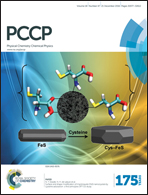Electronic structure of the germanium phosphide monolayer and Li-diffusion in its bilayer†
Abstract
Based on the first-principles calculations, we predict that the monoclinic GeP can be exfoliated into two-dimensional (2D) monolayers. In fact, the interlayer van der Waals interactions are found to be comparable to those in black phosphorus. For the first time, we also elaborate mechanical and electronic properties of the monolayer for possible applications in optoelectronics. Although the monolayer is an indirect-gap semiconductor, it turns into a direct-gap material under appropriate strain. Namely, the material exhibits a direct gap of 2.27 eV under 2% in-plane contraction along the softer (=a) axis. In addition, the contraction brings about an appreciable decrease in the effective mass of electrons along the b direction. The monolayer also practically turns into a direct-gap material under 4% tensile strain along the b direction. These results are particularly interesting, because our calculation indicates that the monolayer is about four times softer than graphene. Based on the calculation of activation barriers for various possible paths, we also identify anisotropic Li-diffusion paths on the GeP monolayer as well as in the interlayer region of its bilayer. In the interlayer region, four parallel paths are identified along the b direction, where a Li atom can diffuse ∼50 times faster than in the graphene bilayer. Our detailed calculations suggest that GeP can be also useful as an anode material in lithium ion batteries.


 Please wait while we load your content...
Please wait while we load your content...